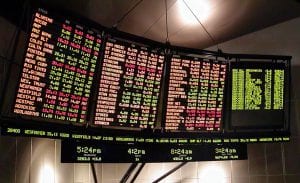Dec 25, 2023
MACD False Signals: Navigating the Seductive Allure of Deceptive Market Trends
Introduction: The Allure of MACD
Technical analysis, a captivating domain, is replete with indicators and chart patterns that allure traders with the prospect of lucrative trading opportunities. One widely used tool is the Moving Average Convergence Divergence (MACD). This tool is a favourite among traders as it aids in pinpointing potential buy and sell signals. However, it’s not always as reliable as it seems. The MACD can sometimes mislead traders with its “MACD False Signals.”
Similar to a siren’s song, these misleading market trends can beguile traders into making imprudent decisions. MACD false signals are essentially deceptive market trends that can lead traders to believe that a particular security will change direction. This can result in traders making hasty decisions based on false signals, leading to significant losses.
MACD false signals are challenging to identify, especially for novice traders. They can appear due to sudden market volatility or due to the influence of other market factors. Traders must understand that while the MACD is a powerful tool, it’s not infallible. It’s essential to corroborate the signals it provides with other indicators and market data to ensure the accuracy of the trading decision.
The MACD is just one of the many tools available to traders in technical analysis. While it can provide valuable insights, it’s important to remember that it’s not a magic wand that can predict market movements with absolute certainty. Traders must exercise caution and use their judgment when interpreting the signals it provides. By doing so, they can avoid the pitfalls of MACD false signals and make more informed trading decisions.
MACD: A Brief Overview
Before we delve into the complexities of MACD false signals, it’s essential to understand what MACD is. The Moving Average Convergence Divergence (MACD) is a momentum indicator that follows the trend. It illustrates the correlation between two moving averages of a security’s price. The MACD triggers technical signals when it crosses above (indicating to buy) or below (suggesting to sell) its signal line. The pace of these crossovers is also considered a signal of a market being overbought or oversold. However, these signals can sometimes be deceptive, leading to the term “MACD False Signals.”
MACD False Signals occur when the MACD generates a buy or sell signal, but the price does not follow the expected trend. This can lead to traders making decisions based on these false signals, resulting in potential losses. For instance, if the MACD generates a buy signal, but the security price decreases instead of increasing, the trader who acted on the signal would incur a loss.
Understanding MACD false signals requires a deep knowledge of how MACD works. The MACD line is the difference between two exponential moving averages, and the signal line is an exponential moving average of the MACD line. When the MACD line crosses above the signal line, it generates a bullish signal, indicating that it might be a good time to buy. Conversely, when the MACD line crosses below the signal line, it generates a bearish signal, suggesting it might be a good time to sell.
However, these signals are not always accurate. Market conditions, such as volatility, can cause the MACD to generate false signals. Therefore, traders should not rely solely on the MACD to make trading decisions. Using other technical analysis tools and looking at broader market conditions is crucial to making informed trading decisions. This way, traders can minimise the risk of falling for MACD false signals and maximise their potential for successful trades.
The Seductive Allure of MACD False Signals
MACD-false signals can be incredibly enticing, often mimicking the traits of authentic MACD signals. These signals can lead traders to believe that a market trend has been established, prompting them to enter or exit a trade. However, these false signals can result in missed opportunities or even losses.
For instance, the MACD may generate a bullish signal, suggesting it’s an opportune time to buy. However, if this signal turns out to be false, the price may unexpectedly reverse its course and move downward. This sudden shift can lead to potential losses for traders who acted based on the initial bullish signal. Similarly, a false bearish MACD signal could prompt traders to prematurely sell their holdings, causing them to miss out on potential profits if the price unexpectedly ascends.
The allure of MACD’s false signals lies in their deceptive nature. They often appear during periods of high market volatility, when rapid price changes can cause the MACD to generate false buy or sell signals. These signals can seem very convincing, especially to less experienced traders who may not have the knowledge or skills to distinguish between genuine and false signals.
To avoid falling into the trap of MACD false signals, traders need to adopt a more comprehensive approach to market analysis. This involves using other technical indicators in conjunction with the MACD to confirm its signals. For example, traders could use the Relative Strength Index (RSI) or Bollinger Bands to verify the MACD’s signals. Additionally, traders should also consider fundamental factors such as economic news and company earnings reports, which can significantly impact market trends.
Mass Psychology: Bypassing the False Signals
So, how can traders navigate the seductive allure of MACD false signals? The answer lies in mass psychology. By understanding the collective behaviour of market participants, traders can gain insights into market trends that might not be apparent from technical indicators alone.
Mass psychology plays a crucial role in interpreting MACD signals. For instance, when markets are trading in the overbought range, but not the highly overbought range and bullish sentiment readings are below 50, mass psychology suggests that the market is not ready to pull back sharply. In such scenarios, even if the MACD gives a sell signal, it might be false.
Similarly, when markets are trading in the oversold range but not the highly oversold range and bearish sentiment is not at least below 20, it might not be time to buy aggressively. Even if the MACD gives a buy signal, it could be deceptive.
The concept of mass psychology is based on the idea that the collective behaviour of market participants can influence market trends. Various factors, including economic news, political events, and social trends, can drive this cooperative behaviour. By understanding these factors and how they influence market sentiment, traders can gain a deeper understanding of market trends and make more informed trading decisions.
For example, if many traders believe that a particular security is overvalued, they may start selling their holdings, causing the price to fall. This selling pressure could trigger a sell signal from the MACD. However, if the bearish sentiment is not strong enough, the price may not lose as much as expected, resulting in a false sell signal.
On the other hand, if many traders believe that security is undervalued, they may start buying, causing the price to rise. This buying pressure could trigger a buy signal from the MACD. However, if the bullish sentiment is not strong enough, the price may not increase as much as expected, resulting in a false buy signal.
Gauging Market Sentiment
But how do we gauge market sentiment accurately? Here’s where personal observations and conversations come into play. If your hairstylist or taxi driver is talking about buying stocks, it’s likely that the market is in a state of euphoria and a top might be close. Conversely, if fear is gripping the market and people around you are avoiding stocks, it might be an excellent time to buy.
The idea of using personal observations and conversations to gauge market sentiment is based on the principle that the mood of the general public can often reflect the overall sentiment of the market. This is because the market is made up of a multitude of individual investors, each with their own perceptions and beliefs about the state of the market. When these individual perceptions align in a certain way, they can create a collective sentiment that can influence market trends.
For instance, if you notice that people around you, who are not typically involved in the stock market, are suddenly showing an interest in buying stocks, it could be a sign that the market is becoming overly optimistic. This is because when the general public becomes interested in the stock market, it often means it has been performing well, and people hope to cash in on the trend. However, this can often lead to a state of euphoria, where people start to ignore the risks and only focus on the potential rewards. This can often signal that the market is reaching the top and a correction might be imminent.
On the other hand, if you notice that people around you are becoming fearful and are avoiding stocks, it could be a sign that the market is becoming overly pessimistic. This is because when the general public starts to fear the market, it often means that it has been performing poorly and people are trying to avoid further losses. However, this can often lead to panic, where people start to sell their stocks indiscriminately. This can often signal that the market is reaching a bottom, and a rebound might be imminent.
In essence, by paying attention to the mood of the people around you, you can gain valuable insights into the market’s overall sentiment and make more informed investment decisions.
Conclusion: The Art of Navigating MACD False Signals
Understanding MACD false signals and how to navigate them is more of an art than a science. It requires a solid understanding of the MACD indicator, keen observation skills, and mass psychology. By combining technical analysis with insights into market sentiment, traders can bypass the deceptive allure of MACD false signals and make more informed trading decisions.
Remember, while the MACD is helpful, it is not infallible. It’s just one of the many indicators that traders can use to analyse market trends. Successful trading involves a healthy mix of technical analysis, an understanding of market psychology, and a bit of luck.
Diverse Views: Compelling Insights




